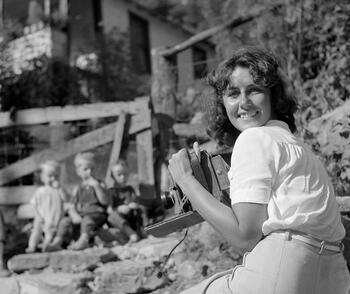Capturing U.S. History and Humanity: The Photographs of Marion Post Wolcott
Capturing U.S. History and Humanity: The Photographs of Marion Post Wolcott
SPICE will feature a selection of Marion Post Wolcott’s photographs in an ongoing series along with organizing questions for educators.

Back in the late 1930s and early 1940s, when it was still relatively novel to use photographs in the press to inform and influence public opinion and policy, Marion Post Wolcott captured images of life in rural America to galvanize support for the New Deal. She was hired as a photographer for the Farm Security Administration (FSA), a federal agency dedicated to improving the lives of America’s most impoverished farmers. Her images vividly exposed the social and economic conditions wrought by the Great Depression and Dust Bowl, and included tenant farmers, migrant workers, cotton pickers, among others, all living in poverty and racially divided communities.
Only the second woman hired on the project, Marion traveled backroads for weeks on end alone—a brave and determined assignment for a young, white woman at that time. She was influenced early by a traveling mother who pioneered birth control clinics with Margaret Sanger and a loving relationship with her Black caregiver, and was later exposed to progressive ideas, art, and education in New York City and Austria as Hitler rose to power. These experiences helped Marion view inequity and injustice through the lens of race, class, and gender, and her interest in photography deepened as a way to illuminate complex issues and influence social change.

At the height of her photographic career, Marion’s professional life suddenly ended in 1942, after she met her husband Lee Wolcott, an assistant to Secretary of Agriculture Henry Wallace and recent widower with two young children. Amid the frenzy of McCarthyism, the Wolcotts opted to leave D.C. and try their hand at farming. Marion put down her camera to focus on the demanding roles of farm wife and mother to her growing family.
Years later, leaving the farm for her husband’s USAID posts in Iran, Egypt, Pakistan, and India, Marion picked up her camera again to capture social and political images. Upon retirement back in the United States, she continued photographing people and activities of personal interest such as anti-war protests and other social movements. Some of these images have been included in exhibits and media as FSA photographs became increasingly featured in present-day discussions. Her FSA film negatives remain archived in the U.S. Library of Congress and her prints are included in major collections including the Metropolitan Museum of Art and Smithsonian Institute.
Despite late recognition, Marion often reflected on and grappled with the hard choices women of her generation faced as they tried to balance raising a family with a professional career. A few years before her death in 1990, as a keynote speaker at a Women in Photography Conference, Marion said to her audience:
Marion Post Wolcott is my grandmother and her photographs have been the wallpaper of my life. A tenant farmer’s child with bowed legs from rickets walking down a path of parched earth, migrant vegetable pickers and coal miners, African Americans in fields of cotton and jitterbugging in a juke joint, bountiful landscapes of America the Beautiful (officially requested to reassure and inspire the public), and shots taken for contrast of wealthy patrons at the horseraces and private beach clubs—these are just a few of her images creating a gallery in my home. Marion’s great-granddaughters now ask questions about the scenes and I hear my grandmother’s voice, sense of adventure, humor and deep care as I relate her stories. Despite her compromises and even some regrets, her example of a bold, engaged, and independent woman helped pave the way for generations to come.
SPICE will feature a selection of Marion Post Wolcott’s photographs in an ongoing series along with organizing questions for educators. The themes will relate to those prefaced here—the challenging conditions that spurred the dynamic and far-reaching programs of the New Deal including significant investments in national infrastructure, social security, and public welfare, as well as efforts to change attitudes and inspire compassion toward fellow Americans. The photographs also raise discussions about the influence of an historian’s perspective. For the featured photo in this article, the following questions are recommended:
- This photo was taken when Jim Crow laws were being enforced in the South after the Civil War. What were Jim Crow Laws? What did you first notice in the photo? How does the caption help you understand what was happening at this time in U.S. history? What do you think Marion Post Wolcott was trying to capture in the photograph? How does the photograph help to increase your understanding of written descriptions of Jim Crow laws in your U.S. history textbook?
- What is the significance of the Plessy v. Ferguson (1896) landmark decision of the U.S. Supreme Court?
- What is the significance of the Brown v. Board of Education (1954) landmark decision of the U.S. Supreme Court?
- What acts brought Jim Crow laws to an end?
- What has been the role of the Supreme Court in shaping the history of segregation in the United States?
- Do you think the photo relates to African American lives today and/or to related social movements? Why or why not?



